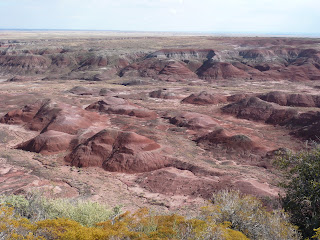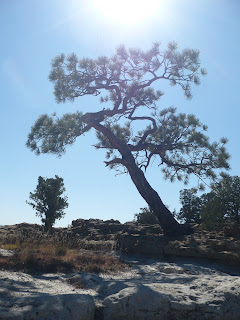But Petrified Forest National Park in Arizona isn’t an ordinary desert.
The Painted Desert at the north end of the park is full of color, which rolls in peaks and mounds far into the distance. Imagine—sand that’s orange or pink or purple or red!
There are striped cones and teepees:
Early settlers called these the badlands:
The Painted Desert Inn was built in the 1920s, and then remodeled by the CCC a decade later. The ceiling has hand-painted glass panels. And there are murals painted by Hopi artist Fred Kabotie in the old lunch room.

 Newspaper rock is a huge rock that’s covered with petroglyphs. The first time I saw it, I was about 12 and you could actually go down stairs and look at them up close. They lasted for 700 to 900 years without problems, but 20th century tourists didn’t do any them good at all. Now, to protect them, the stairs are gone, and you have to view them from an overlook and hope you've got a decent telephoto lens.
Newspaper rock is a huge rock that’s covered with petroglyphs. The first time I saw it, I was about 12 and you could actually go down stairs and look at them up close. They lasted for 700 to 900 years without problems, but 20th century tourists didn’t do any them good at all. Now, to protect them, the stairs are gone, and you have to view them from an overlook and hope you've got a decent telephoto lens. 
At the south end, petrified logs are scattered all over the place, jewel-toned rocks reclining on the desert floor. These are at the Crystal Forest:


It’s about a 2 mile hike from the Rainbow Forest Museum, although it used to be closer. When George & I were there on our honeymoon in 1990, there was a parking lot nearby. Now the old road is the “trail”:



















































